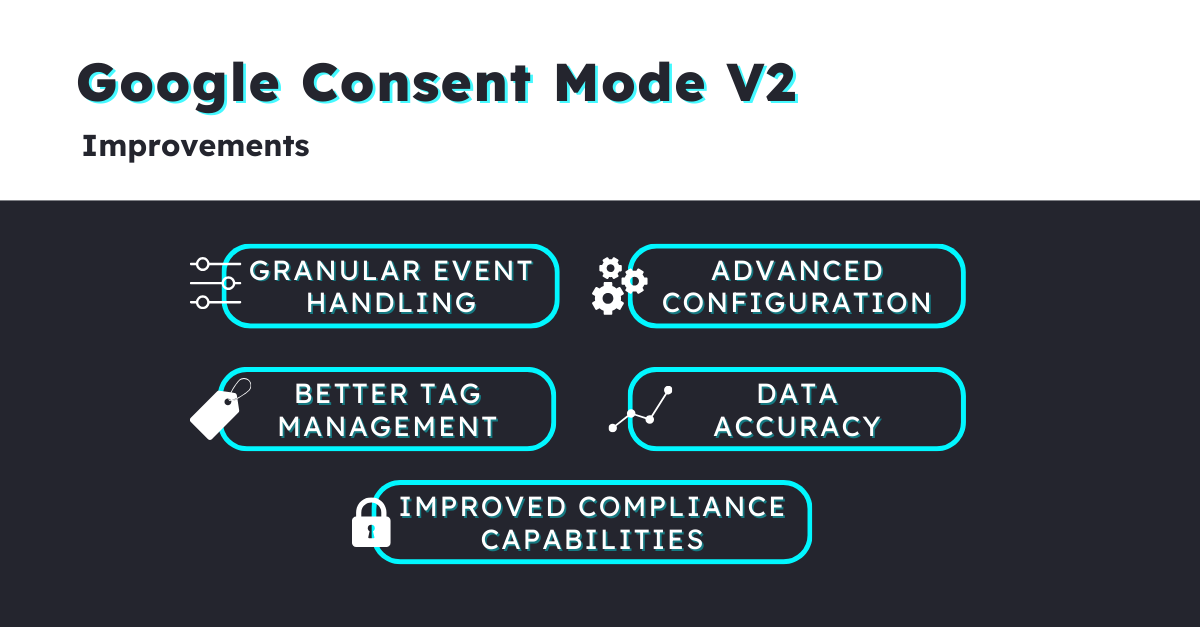[Updated on the 19th of April 2024]

From data breaches to lack of data control, digital privacy continues to be a major concern for our users. So companies like Google have implemented consent management tools to comply with privacy regulations. One of these tools is Google’s Consent Mode, which allows website owners to adjust their analytics and advertising tracking based on user consent.
Table of Contents
What is Google Consent Mode?
Google Consent Mode is a tool introduced by Google to help website owners comply with privacy regulations such as the General Data Protection Regulation and the California Consumer Privacy Act. It allows website owners to adjust their analytics and advertising tracking based on user consent, ensuring that user privacy is protected.
When a user visits a website with Google Consent Mode enabled, the tool automatically detects the user’s consent status based on their browser settings and other factors. If the user has not given consent to tracking, Google Consent Mode will prevent data from being sent to Google Analytics and Google Ads. However, if the user consents to tracking, Google Consent Mode will send information to Google Analytics and Google Ads with limited data access for website owners.
What Should I Know About Google Consent Mode V2?
Google Consent Mode v2 is an enhanced version of its original release, designed to provide website owners with more refined control over data collection in compliance with privacy regulations like GDPR.
Here are some detailed aspects and new features that you should be aware of:
Enhanced Features and Improvements

- Granular Event Handling: Google Consent Mode v2 allows for more granular control over event handling based on user consent status. This means that you can configure specific behaviors for different types of events (such as page views, clicks, or form submissions) depending on whether consent has been given.
- Improved Tag Management: With the update, there is better integration with Google Tag Manager, which simplifies the process of managing and deploying tags based on the consent status. This integration allows for dynamic consent checks before firing tags, ensuring compliance at every interaction.
- Advanced Configuration Options: Version 2 offers advanced configuration options that allow for more detailed settings in how data is handled and processed. This includes the ability to adjust settings not just for advertising and analytics cookies, but for additional parameters that might affect compliance and user experience.
- Better Data Accuracy: By providing options to fine-tune the consent handling process, Google Consent Mode v2 helps maintain data accuracy even under strict consent restrictions. This is particularly useful for analytics and reporting, ensuring that data insights remain robust despite limited data collection capabilities.
- Enhanced Compliance Capabilities: With stricter data privacy laws and varying regulations across regions, Google Consent Mode v2 is designed to offer better compliance capabilities, ensuring that websites can meet legal requirements more effectively while still leveraging Google’s tools.
Implementation Considerations
- Technical Setup: Integrating Google Consent Mode v2 requires some technical knowledge, particularly in JavaScript and possibly Google Tag Manager. It’s crucial to understand how to set up and configure the system correctly to ensure it functions as intended.
- Testing and Validation: After implementation, thorough testing and validation are essential to ensure that the consent mode settings are working correctly, and that data collection adheres to user preferences and legal standards.
- Ongoing Updates: Keep abreast of any further updates from Google, as the digital privacy landscape is constantly evolving. Regular updates may be necessary to maintain compliance and functionality.
Strategic Implications for Businesses
- User Trust and Transparency: Employing a tool like this one can enhance user trust, as it visibly adheres to privacy regulations and respects user choices. This transparency can lead to better user engagement and brand loyalty.
- Balancing Analytics with Privacy: V2 helps businesses balance the need for detailed analytics with the requirement to respect user privacy. This balance is crucial for businesses that rely on data-driven decision-making but also need to comply with privacy laws.
- Adaptability to Regulatory Changes: With an adaptable tool like Google Consent Mode, businesses can more easily adjust to changes in privacy regulations, reducing the risk of non-compliance and potential penalties.
Ebook: Predictive analytics for business strategy
Dive deep into the future of business intelligence and learn how to leverage AI for strategic advantage.

Why has Google Consent Mode been updated?
Google Consent Mode has been updated primarily to address the evolving regulatory environment around data privacy, particularly in Europe under the General Data Protection Regulation, and to address the DMA concerns around gatekeeping.
The Digital Markets Act (DMA) is a European Union regulation designed to promote fair competition and regulate the behavior of “gatekeeper” platforms, which are large online companies that control access to significant markets. Although the DMA focuses primarily on competition and the operation of large online platforms, it can indirectly influence tools like Google Consent Mode v2.
Here’s how the DMA affected Google Consent Mode v2:
- Increased Scrutiny on Data Practices: The DMA mandates transparency in how gatekeeper platforms handle data, requiring Google to disclose more about how data is collected, used, and shared.
- Data Portability and Interoperability: One of the objectives of the DMA is to enhance data portability and interoperability among platforms. For Google Consent Mode, this means adjustments to ensure that data handled through their system can be easily transferred or used across different services in compliance with DMA requirements.
- Compliance Requirements: While Google Consent Mode is primarily a response to privacy regulations like the GDPR, the broader regulatory environment under the DMA could necessitate additional compliance measures. This might include ensuring that the tool does not favor Google’s services over those of competitors.
- Enhanced User Control: The DMA’s focus on giving users more control over their data aligns with the purpose of Google Consent Mode. So for that reason, future updates to the tool will further enhance user control mechanisms to align with DMA directives, ensuring users have clear choices regarding data use.
Cookieless Analytics with Pathmonk Intelligence
Traditionally, website analytics tools such as Google Analytics rely on cookies to track user behavior and gather data. However, with the increasing focus on privacy and data protection, many website owners are looking for cookieless analytics solutions.
One such solution is Pathmonk Intelligence. Unlike Google Consent Mode, which is designed to manage user consent for the use of cookies and tracking technologies, one of the key advantages of Pathmonk Intelligence is its privacy-friendly approach. As a cookieless analytics tool, it is fully compliant with GDPR and other data protection regulations. This means that you can gather valuable data on user behavior without compromising their privacy or violating any laws.
By using machine learning and AI algorithms, Pathmonk Intelligence uncovers specific behaviors and top paths to conversion, allowing you to optimize your website and improve your conversion rate.
Intuitive Cookieless Analytics for Your Web
Understand your customer journey, find drop-offs, and receive actionable insights with AI.

Pathmonk Intelligence can uncover all touchpoints assisting your conversions so you can prove your strategy ROI. With Intelligence, you can save time wasted monitoring, cleaning, and analyzing data with an automated report that translates data into actionable suggestions. This means that you can focus on optimizing your website rather than spending time analyzing data.
In addition, our tool provides a comprehensive conversion funnel analysis that allows you to see how users move through your website and where they drop off in the conversion process. This information can help you identify areas for improvement and optimize your website for conversions.
FAQS
How is Google Consent Mode GDPR Compliant?
Google Consent Mode is designed to be compliant with the General Data Protection Regulation in the European Union. It provides website owners with tools to manage how Google services on their sites, such as Google Analytics and Google Ads, use cookies and collect data based on the consent preferences of users.
Here’s a breakdown of how Google Consent Mode works with GDPR compliance:
- User Consent: It allows the website to adjust the behavior of Google’s services based on the consent given by the user. If a user does not consent to cookies or other tracking technologies, Google services can adjust their operations to not use these methods.
- Data Processing: When consent is not given for certain types of cookies or data collection, Google Consent Mode ensures that these preferences are respected, and the corresponding types of data collection or cookie placement are not performed. This adherence to user preferences aligns with GDPR’s requirement for user consent before processing personal data.
- Analytics and Advertisements: Even without consent for cookies, Google Consent Mode enables basic measurements and does not completely block functionality like analytics. It does so in a way that respects the user’s consent choices, providing aggregated data without identifying individual users.
- Transparency and Control: It supports transparency and control, which are key aspects of GDPR, by helping websites manage consent more effectively and ensuring that users are aware of and can control what data is being collected and used.
However, it’s crucial for businesses using Google Consent Mode to ensure that their overall approach to data protection and privacy complies with GDPR. This means implementing proper consent mechanisms, being transparent about data use, and having robust data protection measures in place. Google Consent Mode is a tool that can aid in compliance, but it does not automatically guarantee GDPR compliance on its own. Each business must assess its specific practices and ensure they align with GDPR requirements.
How Do I Know if Google Consent Mode is Enabled?
Great question. If you want to check whether Google’s Consent Mode is enabled on your website, you can follow these steps:
- Open your website in Google Chrome or any other web browser.
- Right-click on the page and select “View Page Source” from the menu.
- This will open the page source code in a new tab or window. You can use the “Find” feature (usually accessed by pressing Ctrl+F or Command+F) to search for the term “consentmode”.
- If the term “consentmode” appears in the source code, it means that Google’s Consent Mode is enabled on your website.
- Alternatively, you can use the Google Tag Assistant browser extension to check if Google’s Consent Mode is enabled on your website. After installing the extension, navigate to your website and click on the Tag Assistant icon in the browser toolbar. The extension will analyze your website and show you a report that includes information on whether Consent Mode is enabled.
It’s important to note that if Google’s Consent Mode is enabled on your website, you should also ensure that it’s properly configured to comply with GDPR requirements, just as we mentioned above. You may want to work with a GDPR compliance expert or consult Google’s documentation to ensure that your Consent Mode implementation is GDPR compliant.
What If a User Doesn’t Accept?
When a user does not accept cookies or data collection in Google Consent Mode, the system modifies the functionality of Google services accordingly:
- Google Analytics: Operates in a limited mode, collecting only basic and aggregated data, such as page views and session duration, without personal identifiers.
- Google Ads: Only non-personalized ads are shown, and conversion tracking is reduced, impacting the accuracy of campaign performance data.
- Google Tag Manager: Tags requiring consent will not activate unless consent is explicitly granted.
Here are the operational implications for website owners:
- User Experience: Maintain seamless functionality despite the limited data collection to ensure a positive user experience.
- Compliance and Transparency: Be transparent about data usage to build trust and possibly encourage consent.
- Analytics Impact: Be prepared for limited insights from analytics, which may require adjustments in data-driven decision-making strategies.







